China tour from Beijing to Shanghai in 2022 is the perfect choice for those who want to see the beautiful sights of China. On this 10-day tour, you will visit four cities, Beijing, Xi’an, Zhangjiajie, and Shanghai. By taking Beijing and Xi’an tour 2022, you will be taken to the Forbidden City to experience the luxurious life of the ancient royal family. Sitting on a rickshaw, you’ll go through the old hutongs and enter the charming courtyards. In Xi’an, we will visit the 2,000-year-old Terracotta Warriors and Horses and the Big Wild Goose Pagoda where Master Xuanzang collected Buddhist scriptures, and experience the charm of this ancient city. Visiting Zhangjiajie in 2022, you will walk on the Hanging Blank Road and Glass Bridge to see the magic of nature. During your trip to Shanghai, you will not only be able to visit the Bund and witness the centuries of change in this cosmopolitan city, but also have the opportunity to ride the world’s fastest elevator up the tallest skyscraper in China, which is the perfect place for taking photos. No more just reading a boring guidebook and let's get on a flight to China.

Welcome to Beijing, the capital of China. It is also an ancient city with a history of more than 3,000 years, covering an area of 16,410 square kilometers. Beijing has a typical temperate monsoon climate, making it a great city to travel. On arrival, your guide will be waiting for you at the airport with your name sign so that you can find him/her easily. You will then be taken to the hotel and check in. Rest up today and tomorrow we will start our 10-day tour! Over the next two days, your guide will take you to many places with Beijing characteristics, taste Beijing cuisine, and show you the charm of this ancient city.
When you visit Beijing in 2022, your first stop is Tian’anmen Square, the center of Beijing. Tian’anmen Square is 880 meters long from north to south and 500 meters wide from east to west, covering an area of 440,000 square meters and can accommodate a grand gathering of one million people. In the square, you can see the National Flag Pole, the Monument to the People’s Heroes, the Memorial Hall of Chairman Mao and the Zhengyanmen Gate Tower standing in order along the central axis of Beijing from north to south. As the center of the capital, Tian’anmen Square has witnessed many important political and historical events. For example, on 12 February 1912, Empress Dowager Longyu issued an edict of abdication in the name of Emperor Xuantong from Tian’anmen Square. The last Chinese emperor abdicated, announcing the end of China’s last feudal dynasty. In 1949, the founding ceremony of the People’s Republic of China was also held here. Not long ago, more than 70,000 people gathered here to celebrate the 100th anniversary of the founding of the Chinese Communist Party.
Next stop, we are going to the Forbidden City (closed each Monday). The Forbidden City, located in the center of the central axis of Beijing, is the royal palace of China’s Ming (1368-1644) and Qing (1616-1911) Dynasties. Covering an area of about 720,000 square meters, the Forbidden City has more than 70 large and small palaces and more than nine thousand rooms. It is also one of the largest and best-preserved wooden structures of palace groups existing in the world. The buildings in the Forbidden City are divided into two parts: the Outer Court and the Inner Court. The main halls of the Outer Court are the Hall of Supreme Harmony, the Hall of Central Harmony and the Hall of Preserving Harmony, collectively known as the Three Great Halls, where the great national ceremonies are held. When we visit the Three Great Halls, we may notice that there is not a single tree to be found around such a large place. Trees are common in many ancient buildings, but why are there no trees here? Firstly, it was for the safety of the emperor. Once an assassin climbed up the high wall of the palace through a tree, trying to assassinate the emperor’s son. Although the assassin didn’t succeed, this incident strongly scared the emperor at the time, and he ordered the trees to be cut down and not planted again for fear that another assassination would occur. Secondly, it was for fire prevention. Wood was the main building material at that time, but it is flammable. Due to lightning strikes, the Forbidden City has already caught fire many times. If trees had been planted around the Three Great Halls, the fire would surely would spread fast in the event of a fire. Now there is no emperor in the palace, but for the sake of fire prevention, there are still no trees planted around the Three Great Halls.
After lunch, you will be driven to the Temple of Heaven, covering an area of 2,730,000 square meters, almost four times of the Forbidden City. Built in 1420, the Temple of Heaven was the place where the emperors of Ming and Qing Dynasties offered sacrifices to heaven and prayed for a good harvest. The two main buildings of the Temple of Heaven are the Circular Mound Altar and the Hall of Prayer for Good Harvests, both of which were used to worship heaven. In the Temple of Heaven, there are many cypresses, including a 500-year-old cypress named Nine Dragon Cypress. The trunk of the tree is strangely textured, grooved, and twisted, resembling nine dragons twisting and playing. The tree was named by Emperor Qianlong, the sixth emperor of the Qing Dynasty (1636-1912). Legend has it that Emperor Qianlong once came to the Temple of Heaven to make a sacrifice. When he finished inspecting the preparations for the ceremony, he was resting under a wall when he suddenly heard a strange sound. Then he ordered his followers to catch them who made the sound but failed. Suddenly, he found a tree outside the wall, the surface of its trunk was covered with grooves which looked like dragons. Emperor Qianlong thought the sound may be from the nine dragons on this tree, so he named it Nine Dragon Cypress.
Next, we are going to visit the Summer Palace, an imperial garden for the royal family in the Qing Dynasty. The garden covers an area of about 3 square kilometers, with about three-quarters of the water area and more than 3,000 garden buildings in various forms. The Summer Palace is a large landscape garden modeled on the West Lake in Hangzhou and is one of the best-preserved royal gardens in China. The garden was based on Kunming Lake and Longevity Hill. If you climb up the top of Longevity Hill, you can get a bird’s eye view of most of the garden. You can also see Kunming Lake at the foot of the mountain. The boats glide slowly across the lake, leaving hardly a trace. When the breeze blowing across your cheeks, you may enjoy the relaxing moment!
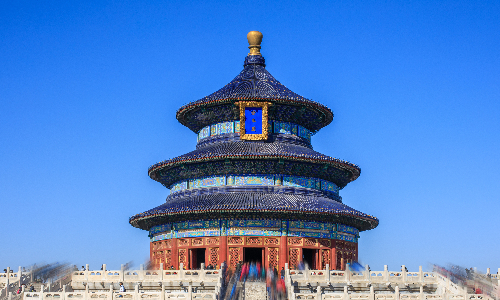
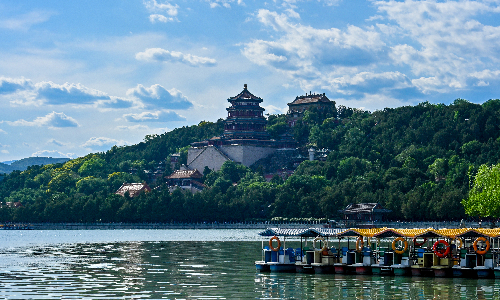
On the last day in Beijing, we are going to visit Hutongs by taking the local rickshaw. Hutong means an alley or small street in Beijing old city area. Hutong area is home to traditional Siheyuan (quadrangle courtyards) in Beijing, with a history of more than 700 years. In Beijing, there are more than 7,000 Hutongs in total, which can be called veins of the city. The names of Hutongs are also diverse, some are named after people’s names, some are named after places, and some are named after markets or goods. When you visit Hutongs on the rickshaw, you will find that these Hutongs are not all the same. The longest Hutong in Beijing is Dongjiaomin Lane, which is 1,552 meters long, and the shortest is only 30 meters long. The narrowest Hutong, Qianshi Hutong, is only 0.75 meters wide, and a slightly overweight person would have to hold his breath to pass through it. In Beijing, Hutongs are not only the veins of the city but also the place where ordinary people live. You can walk into a house here to talk to the local family, and you’ll experience the local daily life in the Hutongs.
After lunch, we will drive northeast for about 1 hour and 20 minutes to go to Mutianyu Great Wall, 65 kilometers away from the Hutongs. With a total length of 5,400 meters, Mutianyu Great Wall connects with Gubeikou Great Wall in the east and Juyong Pass in the west. Since ancient times, it has been a military fortress for defending the capital and is regarded as the essence of the Great Wall of the Ming Dynasty (1368-1644). The area is full of mountains, with vegetation coverage of over 90%. The construction of the Mutianyu Great Wall has a unique style, with a great number of watchtowers. Mutianyu Great Wall is the only section of Great Wall with crenels on both sides of the wall. The tourist area of Mutianyu Great Wall is well-equipped with all kinds of facilities. You can choose to take a cable car or a chairlift to go up and down the Great Wall and enjoy the unique beauty of the majestic Mutianyu Great Wall. You can also experience the toboggan as you descend from the Great Wall, saving time and effort and having fun at the same time.
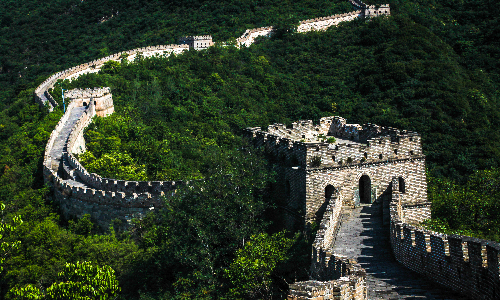
 Xi’an
Xi’an Today, we are going to say goodbye to Beijing and head to Xi’an. In the afternoon, your guide will take you to the train station to take the estimated train G57 14:00/18:24. After you arrive in Xi’an, the ancient capital of thirteen dynasties in China. Upon your arrival, your local guide will wait for you at the destination and transfer you to the hotel. You can also enjoy the night view of this beautiful city on the way to the hotel. Have a good rest tonight, tomorrow we will start our Xi’an tour!
Today, we will drive northeast for about 1 hour to visit the Terra Cotta Warriors and Horses Museum, which is 40 kilometers away from the center of Xi’an. This museum is based on the mausoleum of Emperor Qin Shi Huang, the first emperor of China, and also the largest ancient military museum in China. The Terracotta Warriors and Horses Museum has three pits, covering an area of more than 20,000 square meters. The three pits contain nearly 8,000 pieces of terracotta figures and horses similar in size to real people and horses. There are different types of soldiers including cavalry and infantry, arranged in a neat and orderly manner. Here you will find that the skilled craftsmen of more than 2,000 years ago can produce ingenious works of art despite the lack of modern technology.
After lunch, you will be driven to Big Wild Goose Pagoda. Located in the south of Xi’an, the Big Wild Goose Pagoda has been standing here for nearly a thousand years and is one of the city’s landmarks. The Big Wild Goose Pagoda, located in the Daci’en Temple, was built in the Tang Dynasty (618-907) to house the Buddhist scriptures brought back from Tianzhu(ancient India) by Xuanzang (an eminent Buddhist monk in the Tang Dynasty). The Big Wild Goose Pagoda has been repaired several times in history. When the pagoda was first built, there were only five floors and the pagoda was 60 meters high, which was modeled after the Western pagoda. After it was repaired and rebuilt many times, it is now 64 meters high, with 7 floors and 25 meters long on each side of the bottom.
One of the most noteworthy cultural relics preserved in the Big Wild Goose Pagoda is the Pattra, palm-leaf manuscripts written on the dried leaves. Since there was no paper in ancient India, the Buddhist scriptures were often written on leaves instead, including the 657 scriptures that Xuanzang got from Tianzhu(ancient India). On the fourth floor of the Big Wild Goose Pagoda have been enshrined two pieces of palm-leaf manuscripts about 40 centimeters long and 7 centimeters wide, which are written in Sanskrit, and it is said that there are less than 10 scholars in the world who can read the text, which is very rare.
The last stop of our Xi’an tour in 2022 is the Ancient City Wall, which is the best-preserved city wall in existence, with a history of more than 1,400 years from the Sui (581-618) Dynasty to the present. With a perimeter of about 14 kilometers, the wall was rebuilt in the Ming Dynasty, and a series of facilities such as moats and corner towers were added. When you ascend the wall, you can see the modern high buildings on one side and the old city buildings on the other. This would be an amazing experience.
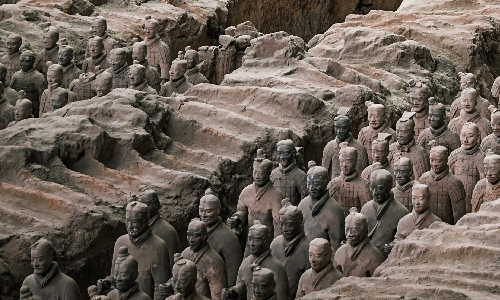
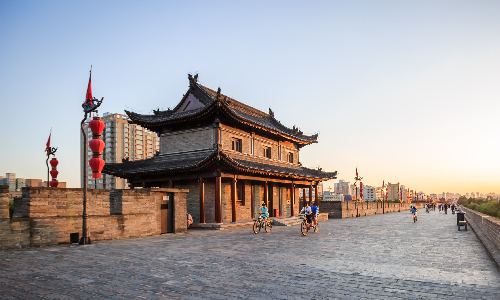
 Zhangjiajie
Zhangjiajie On the last day in Xi’an, you can arrange your time freely in the morning. Then your tour guide will take you to the airport to take the estimated flight 3U3271 14:35/16:05. Upon your arrival, your local tour guide in Zhangjiajie will pick you up at the destination, and then you will be driven to the hotel we have arranged for you for a good rest.
This morning, we will start our tour by visiting the Zhangjiajie Grand Canyon. We are going to drive northeast for about 2 hours to the Grand Canyon, which is about 60 kilometers away from the center of this city. The lush vegetation and fresh air will make people feel cool and comfortable. The stream here is covered by a layer of mist, which is so beautiful that people will feel relieved of worries here.
Here we will walk up the Hanging Plank Road, a narrow and steep plank road. The whole road has wide and narrow places, and the narrowest place can only accommodate one person. And it is very steep and the steps here are relatively high. While experiencing the excitement, pay attention to safety.
Next, we will walk through the Zhangjiajie Glass Bridge in Tianmen Mountain. This bridge will bring you a sense of excitement and can be comparable to the world-famous “Grand Canyon Skywalk” in the United States. On sunny days, the reflection of the blue sky and white clouds spreads over the entire walkway, making people tremble at the hundreds-of-meter height under the transparent glass while enjoying the thrill of walking on clouds. In cloudy days, the glass walkway is hidden in the fog, which makes you wonder about the beautiful scenery of this earthly wonderland. No matter what season or weather you come here, Zhangjiajie Grand Canyon will always bring you a different kind of beauty.
After lunch, you will be driven to Baofeng Lake, which has been called the classic of the world lakes. Baofeng Lake is surrounded by green hills, with lush trees, flowers and grass, and a variety of melodious birdsong. In the middle of the mountains is the Baofeng Lake, the water of which is very clear but cannot be seen to the bottom, as it is 72 meters deep. The shadows of the high green hills are reflected on the lake, making it look even more turquoise, like a crystal-clear emerald. In this picturesque place, you can not only feel the endless charm of nature but can also relax your nerves and get involved in this breathtaking scenery.
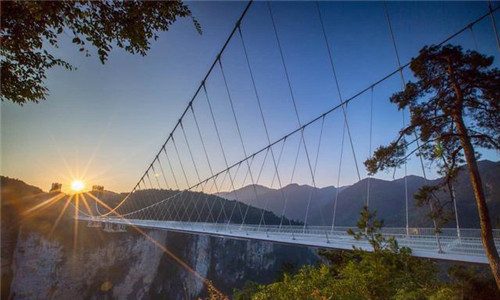
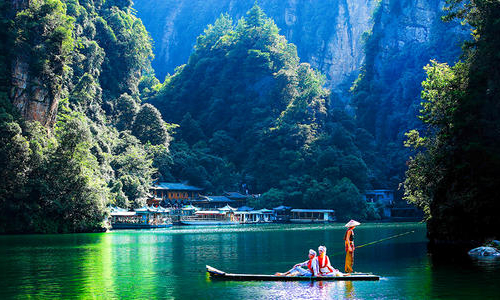
 Shanghai
Shanghai Today, we are going to say goodbye to Zhangjiajie and fly to Shanghai, the last destination of our tour. Your tour guide will take you to the airport to take the estimated flight MU5196 12:30/14:30. Your guide in Shanghai will pick you up there, and you will be driven to the local hotel to have a good rest.
This morning, your tour guide will take you to Jing’an Temple, the most ancient and magnificent temple in Shanghai. Different from other temples built in remote mountains, Jing’an Temple was built at the center of Shanghai. Legend has it that Metro Line 2 was to pass under the temple, but an ancient spring with some magic incantations engraved on its guardrails was dug out of the ground during construction. A senior person said that the underground spring was cursed and should be suppressed by a temple that can suppress evil, thus it must not be moved. So, the subway had to change the original line. The legend cannot be confirmed, but they do add some mystery to the Jing’an Temple. When you come here, you can not only get a glimpse of this golden and precious temple but also pray for good luck for yourself.
Next, we will go to the Yu Garden (closed each Monday), which was originally a private garden during the Ming Dynasty (1368-1644) and has been in existence for more than 400 years. The owner of this garden was Pan Yunduan, a government official during the Ming Dynasty. He built the garden for his parents to enjoy their old age. The garden is exquisitely laid out and has a pleasant view. The main attractions here includes Huge Rockery, Sansui Hall, Nine-dragon Pond, Huijing Tower, and so on.
When you visit Shanghai in 2022, a must-see is the Shanghai Tower. After lunch, we will go to the Shanghai Tower, one of Shanghai’s giant high-rise landmark skyscrapers. The building is 632 meters tall, with 127 floors above ground and 5 floors below. 118th and 119th floors are the main sightseeing floors for visitors. It is worth mentioning that the Shanghai Tower’s express elevator has a maximum speed of over 64 kilometers per hour, about 18 meters per second, twice the speed of a normal elevator, making it the fastest elevator in the world. We are going to take the express elevator that goes directly to the 118th-floor sightseeing platform, which will only take 55 seconds. From here you can look down on the city of Shanghai, with all the other buildings underfoot. There is also a coffee shop on the 119th floor, so if you are tired of walking around, it is a good choice to buy a cup of coffee and take a break.
Coming down from the Shanghai Tower, we are going to visit the Bund, which is located on the west bank of the Huangpu River in the central area of Shanghai. To the east of the Bund is the Huangpu River, and to the west are 52 buildings of various styles, including Gothic, Romanesque, Baroque and Chinese and Western, known as the “Exhibition of International Architecture”. When it comes to the Bund, we have to mention the HSBC Building, now Shanghai Pudong Development Bank, which is the largest building with the widest frontage on the Bund. Above the octagonal foyer at the main entrance of this building is a giant mosaic mural, which progresses in three layers full of metaphor. One hundred years ago, this area is the concession of Britain. The sun in the center of the dome is a symbol of the British Empire, which was known as the empire on which the sun never sets. The painting on the first layeris a joyful scene celebrating the harvest consisting of Ceres, the goddess of agriculture, Helios, the god of the sun, and Artemis, the goddess of the hunt and the moon. The second layer is 12 constellations, orbiting the sun in the universe. The earthly patterns on the third layer are the cities where the branches of HSBC are located: Shanghai, Hong Kong, London, Paris, New York, Bangkok, Tokyo, Kolkata. These patterns are based on the buildings of various branches and are symbolized by eight gods, showing HSBC’s global business development and capital expansion. The mural was completed by Italian craftsmen, with exquisite design.
Leaving the Bund, we are going to Nanjing Road, the first commercial pedestrian street in China. Here you can try the traditional snacks of Shanghai, such as smoked fish, meat-stuffed moon cakes, drunken shrimps and drunken crabs. After eating, you can take a look around this commercial street, which is lined with more than 400 stores with a variety of famous domestic and foreign brands, making it a great choice for shopping and entertainment.
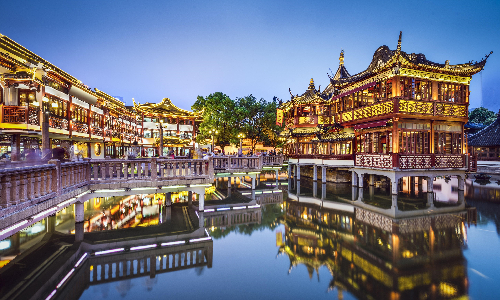
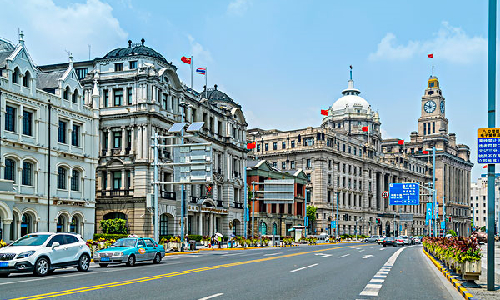
Your China tour is coming to an end. We are very happy to meet you in China and hope you have had a pleasant 10-day trip. Today your guide will take you to the airport and help you check in. Welcome to China again next time.
Editor: Fan Lin
Proofreader: Summer Hou
| City | Five Star hotel list | Four Star hotel list |
|---|---|---|
| Beijing | Sunworld Dynasty Hotel Beijing Wangfujing | Sunworld Hotel Wangfujing |
| Xi'an | Tianyu Gloria Grand Hotel Xi'an | Sunworld Dynasty Hotel |
| Zhangjiajie | Zhangjiajie Qinghe Jinjiang International Hotel | Zhangjiajie Huatian Hotel |
| Shanghai | Ocean Hotel Shanghai | Ambassador Hotel |
 |
![]() About your child or infant, please contact us for a discounted price.
About your child or infant, please contact us for a discounted price.



We started with a few days in Beijing & ended in Shanghai, from where we visited the Forbidden City and Great Wall. In between we visited Terra Cotta Warriors Museum, Panda Base, Shanghai Disneyland.

We had a wonderful holiday in China which will remain long in the memory. China is a breathtakingly beautiful country full of splendid temples and palaces, mountains and rivers, peaceful rural scenes and bustling shopping streets.
 QUICK ENQUIRY
QUICK ENQUIRY